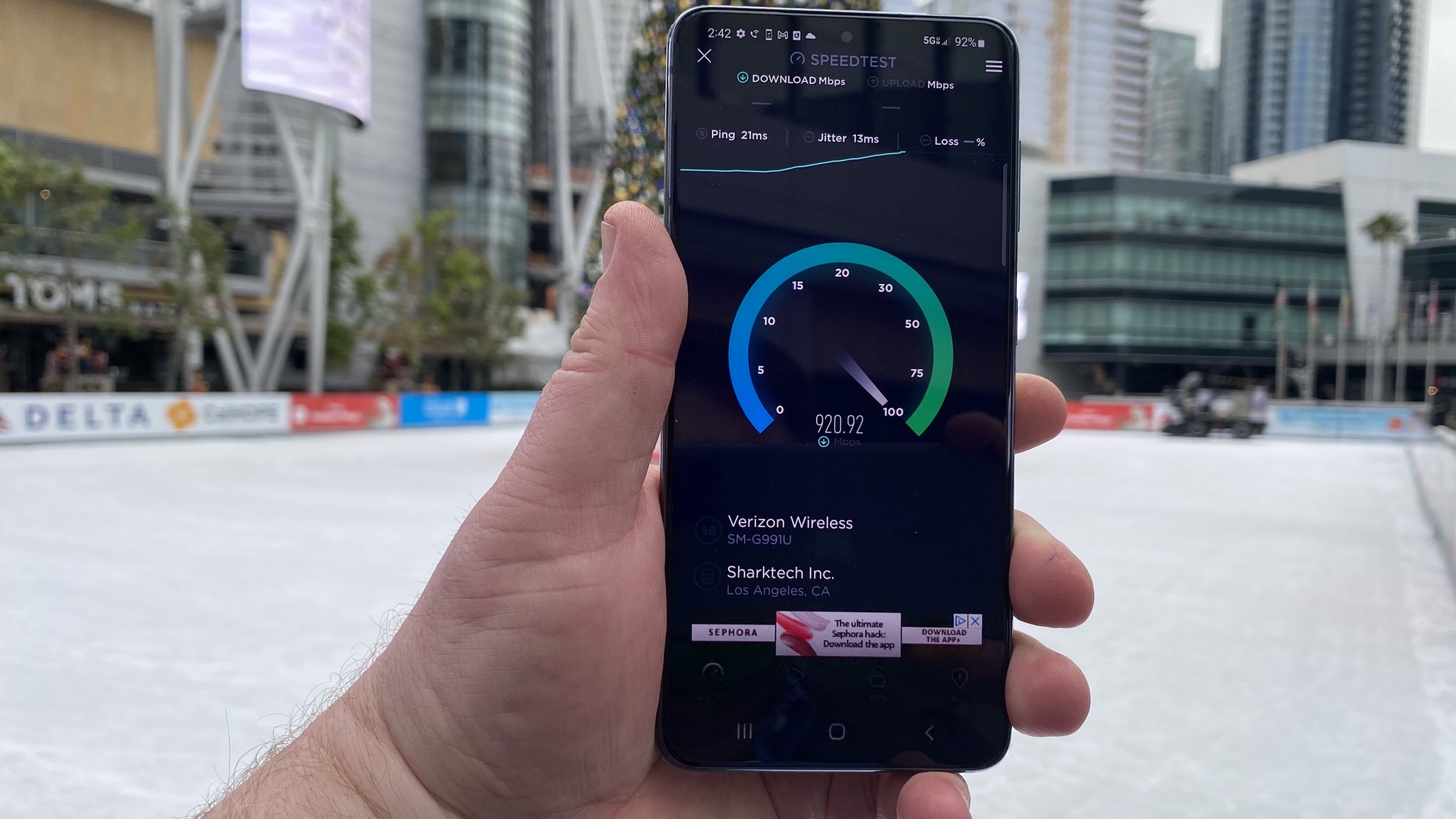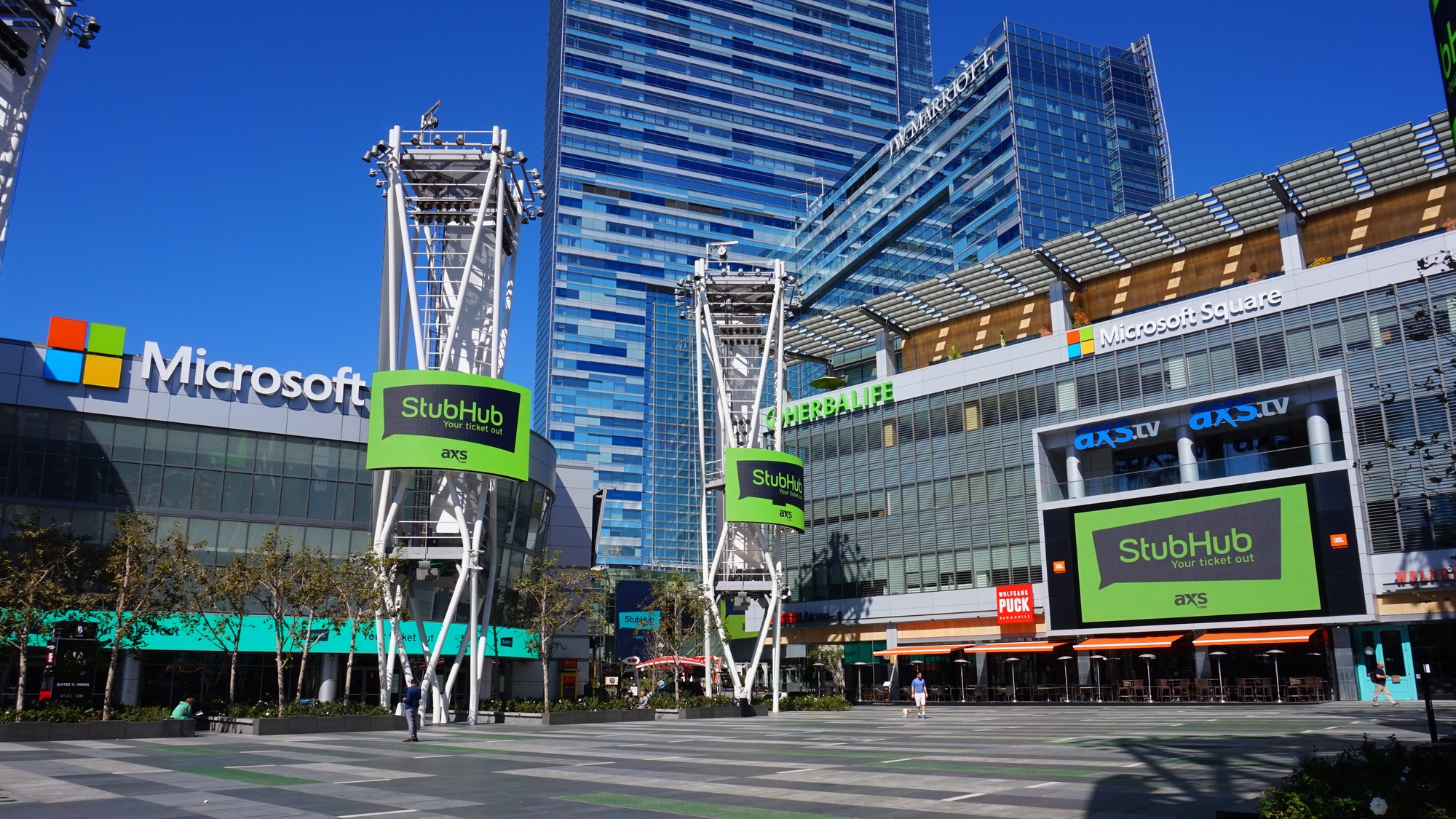Verizon 5G gets ready to take the next leap with C-Band — and I just tested it
Here's how C-Band spectrum will boost 5G performance

LOS ANGELES — As I stood outside the entryway to the arena that houses the Los Angeles Lakers, my phone was seeing download speeds worthy of a Magic Johnson-led fast-break. My download speeds reached hundreds of megabytes per second on average, with a top-speed of nearly 1.6 gigabytes, enough to finally deliver on 5G's promises of faster data and lower latency.
Alas, the speeds weren't on an actual network accessible to anyone. Rather, I was connected to a Verizon test network built on the carrier's C-Band spectrum through a test phone supplied to me by the company. The idea was to see what C-Band can do for both range and performance once Verizon throws the switch on the next stage for its growing 5G network.
And what did I see? A damn fast network.
More importantly, I saw how much Verizon's 5G network has evolved since the carrier first threw the switch on its inaugural commercial 5G network more than two years ago. Back in 2019, I swooped into Chicago to see one of Verizon's first 5G installations built on millimeter wave (mmWave) technology. Speeds then were certainly faster than the LTE connections nearly all of us had, but they were inconsistent and limited to a block-by-block reach.
The test network I experimented with this week offers much faster speeds that are spread out over a wider area. Think of it as Verizon stepping up to the challenge posed by T-Mobile, who currently has the widest reaching 5G network according to third-party test firms while also topping many 5G speed rankings.
Verizon believes that's about to change. By the end of March 2022, it says it will cover 100 million customers with C-Band spectrum after launching that service sometime in the next three months. (Good luck on getting the carrier to say when exactly.) Over the next couple years, that number will grow to 240 million, as Verizon looks to augment its existing 5G network.
It's an ambitious goal, and if you've got a 5G phone that also works with C-Band spectrum, faster speeds could be in your very near future. Here's what I experienced in my testing and what Verizon's efforts will mean for future performance.
Sign up to get the BEST of Tom's Guide direct to your inbox.
Get instant access to breaking news, the hottest reviews, great deals and helpful tips.
How carriers are building out 5G
Building out a 5G network has required carriers to use different types of wireless spectrum to offer the kind of performance and availability their customers expect. T-Mobile has enjoyed a lot of success thus far by using low-band spectrum to launch the first nationwide 5G network at the end of 2019.
T-Mobile's speeds at the time weren't as fast as what other carriers were offering with 5G, but it could reach a wider swath of people. And that's only increased, as the carrier now can reach more than 300 million people with its current 5G coverage. Even better, T-Mobile has used the mid-band spectrum acquired from its merger with Sprint to bolster speeds — 200 million people can now access the faster Ultra Capacity service.
Verizon took a different tack, starting out with mmWave, which delivers the fastest speeds. But mmWave's reach is limited, and you usually have to be in sight of a tower to enjoy those fast speeds. Because mmWave signals can't go around obstructions like windows and buildings, it's nearly impossible to get mmWave speeds indoors, unless you put a node in there (as Verizon has done with many arenas and other high-capacity venues).
As of this writing, Verizon's mmWave-based 5G service reaches parts of 87 cities, while a slower nationwide network covers around 230 million people.

C-Band offers Verizon a chance to combine greater reach with faster speeds. At an FCC auction this spring, Verizon snagged the majority of the available C-Band spectrum with an eye toward using it to expand the reach of its 5G service.
"I could not be happier with the combination we have of low-, mid- and C-Band spectrum," Verizon senior vice president of technology planning Adam Koeppe told reporters who attended this week's test session in Los Angeles.
Testing Verizon C-Band 5G
As far as test sites go for C-Band, Verizon couldn't have picked a better place than the LA Live entertainment district in downtown Los Angeles. The site is wedged between the Microsoft Theater and the former Staples Center (now ridiculously named after a cryptocurrency outfit) where the Lakers, Los Angeles Clippers and Los Angeles Kings all play their home games.
My old iPhone 11 hit a top download speed of 34.9 Mbps; in that same location, the 5G Verizon device rode the carrier's C-Band to just over 1 Gbps.
It's the sort places where crowds regularly convene and where outdoor events are the norm — right now, there's an ice rink set up for people looking to experience some holiday magic. In other words, it's the kind of spread out area where lots of smartphone-toting people are likely to converge, demanding faster download and upload speeds.

Just as importantly, it's a stark contrast to the kind of initial mmWave deployments Verizon was putting into place two years ago to get its 5G network off the ground. In those days, a mmWave node could bring high-speeds to a street corner here or an intersection there.
Verizon's C-Band set-up at L.A. live reaches a wide area, and I was able to enjoy those top download speeds in front of the basketball arena even with towers located on the other side of a very well-trafficked street. The setup could probably reach blocks away, though I wasn't able to establish just how far the reach was in my limited testing time. Suffice it to say, it's a lot more extensive than what I've experienced with Verizon's mmWave service.
That said, there are still some inconsistencies with performance. Standing on the platform of the outdoor ice rank, I registered my slowest speeds on Verizon's test device — a 289 Mbps download speed as measured by Ookla's Speedtest app. Walking maybe 20 feet away, those speeds improved to 611 Mbps, and when I walked across the street to stand by the Kareem Abdul-Jabbar statue, speeds had increased to 841 Mbps.
The reason for the disparity? One of Verizon's network gurus figured I was standing too close to the structure where the C-Band hub was deployed so that the signal was coming in at a suboptimal angle for my phone. The fact that speeds improved the further away I moved seemed to back that theory.
One of the most striking results happened when I fired up Speedtest on my personal iPhone 11 Pro Max, which is connected to Verizon's LTE network. My iPhone hit a top speed download speed of 34.9 Mbps; in that same location, the 5G Verizon device rode the carrier's C-Band to just over 1 Gbps. If you've been reluctant to upgrade to a 5G phone because you just aren't seeing the promised performance improvements, Verizon's C-Band is poised to change your mind.

Verizon showed off other examples of what all this speed will mean beyond faster downloads. I got to test out a Snapchat filter in which I could mimic the powers of Marvels Dr. Strange by making fiery circles appear or multiplying into a dozen versions of myself. It's the kind of demanding data task that only works with the lower latency and faster speeds afforded mmWave-based 5G and now C-Band. (The filter launched earlier this fall as a Pixel 6 exclusive.)
Similarly, another app gave me a live look-in at the Phoenix Suns' arena some 375 miles away in which I could spin around the camera for 360-degree views rendered in real time. Impressive stuff.
Verizon C-Band 5G: What happens next
Not everyone is enamored with C-Band. The aviation industry and the Federal Aviation Administration fear that C-Band could interfere with safety systems on some airplanes. Verizon and AT&T — which also acquired C-Band spectrum in this spring's auction — agreed not to launch C-Band this month, though Verizon has said it's still on track to meet its goal of reaching 100 million customers with C-Band 5G coverage by the end of March.
When Verizon does flip the switch, there are already phones out there that can enjoy the faster speeds right away. iPhone 12 and iPhone 13 models are both equipped to work with C-Band, a Verizon executive told me, as are Samsung's Galaxy S21, Galaxy Z Fold 3 and Galaxy Z Flip 3. (A Verizon spokesperson subsequently added that there are other 5G phones from other device makers that will work with C-Band at launch, too.) You'd imagine that Samsung's upcoming Galaxy S22 flagships might join that list, too, once they arrive in early 2022.
For a lot of smartphone owners, the 5G transition hasn't felt terribly transformative given how modest data speed gains have been up until now. Technologies like C-Band and T-Mobile's ongoing efforts to improve speeds with its own Ultra Capacity 5G figure to change that. And 2022 is already shaping up to be a big year for wireless connectivity.
For the latest offers and discounts, make sure you check our Verizon promo codes page.
Philip Michaels is a Managing Editor at Tom's Guide. He's been covering personal technology since 1999 and was in the building when Steve Jobs showed off the iPhone for the first time. He's been evaluating smartphones since that first iPhone debuted in 2007, and he's been following phone carriers and smartphone plans since 2015. He has strong opinions about Apple, the Oakland Athletics, old movies and proper butchery techniques. Follow him at @PhilipMichaels.

